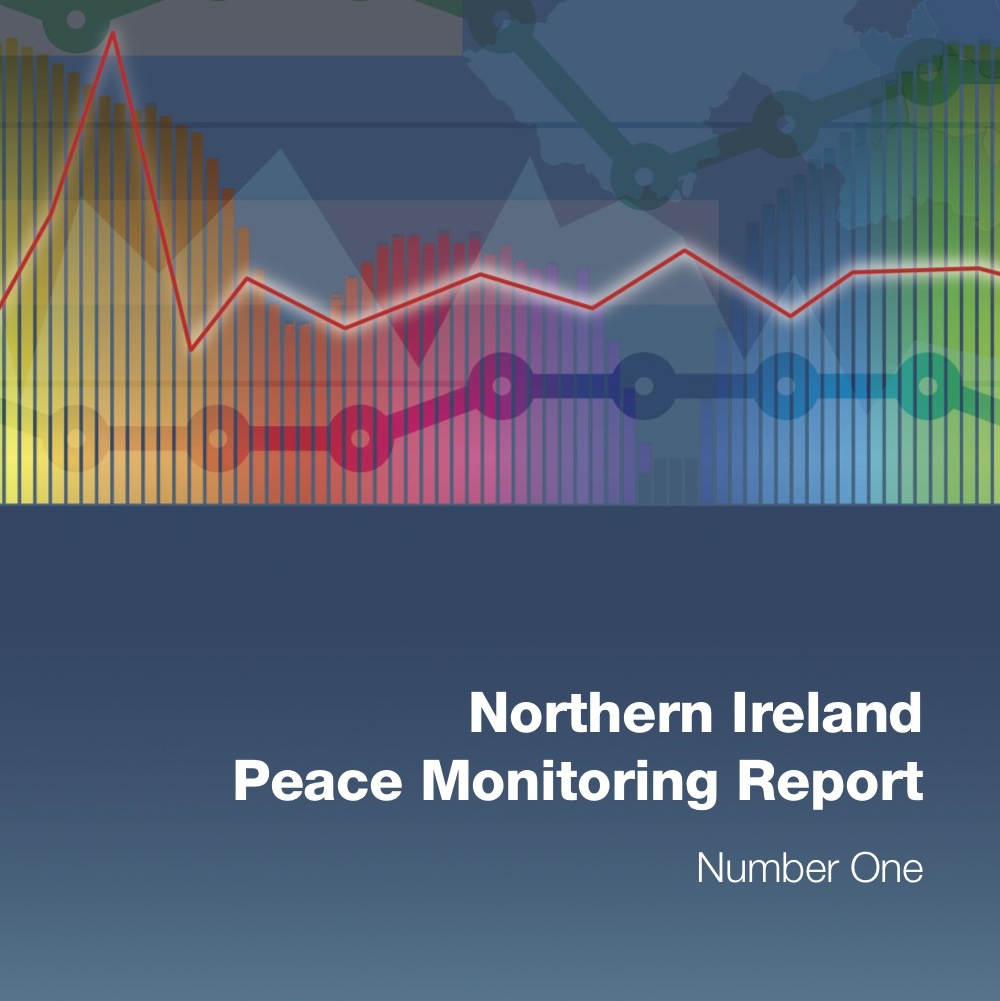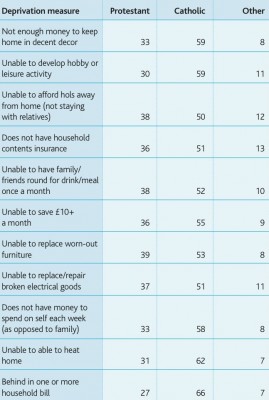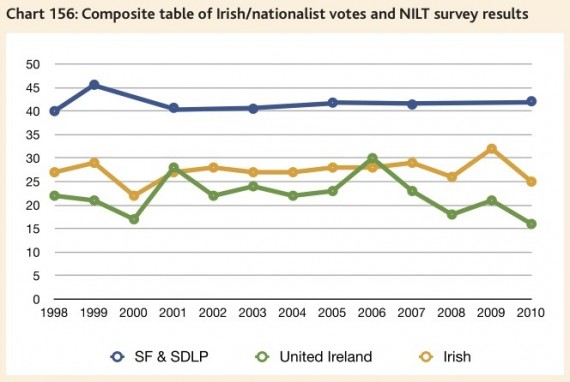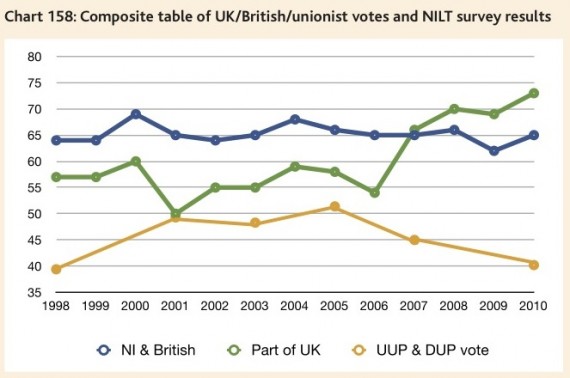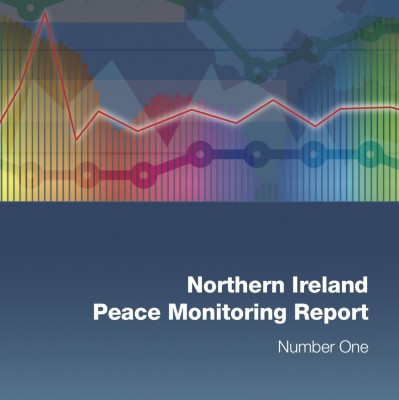 As posted earlier, the Community Relations Council’s first Northern Ireland Peace Monitoring Report was published today.
As posted earlier, the Community Relations Council’s first Northern Ireland Peace Monitoring Report was published today.
It includes a handy reminder of the main moments since 1974 when ‘the hand of history’ has been on the peace process as well as an overview of the demography of Northern Ireland and a profile of its workforce.
Amongst population figures, communal identity breakdown charts and graphs of productivity and living standards, one table explains that compared to the UK as a whole, the employment rate in NI is lower – through the unemployment rate is also lower – and those that are employed work longer hours and are paid less.
Over one third (36.2%) of the economically inactive have no educational qualifications, compared with 12.1% of those in employment …
Northern Ireland has the highest percentage of adults of working age in the UK with no educational qualifications: 20%, compared with 10% of the UK as a whole … [graphed over at poverty.org.uk]
Only 4% of the NI workforce is employed in the knowledge economy, one of the lowest rates in the UK. The reality is that, despite the claims made about the excellence of Northern Ireland’s education system, the workforce is under-qualified. Given its other disadvantages, Northern Ireland needs not just to equal but to outdistance UK averages to secure inward investment.
In the earlier post, I looked at a little of what the report had to say about the changing security situation in Northern Ireland. But what about the other three dimensions?
One of the starkest conclusions under the equality dimension is that poverty is increasing.
The proportion of people who are in low-income households is much higher among Catholics (26%) than among Protestants (16%) … Comparisons across a range of deprivation indicators drawn from the Family Resources Survey [show] on every indicator the percentage of Catholics is higher than the percentage of Protestants.
Fuel poverty is a key theme of the Social Development committee.
Yet I have rarely heard a politician quote these kind of measures to describe poverty in their constituencies. There don’t seem to be votes in highlighting what struggling families endure.
Despite their socialist and civil rights history, parties like Sinn Fein and the SDLP don’t often seek to vigorously campaign or make political capital out of these tangible measures.
The report reproduces the eye-catching analysis from last year’s DHSSPS’s Health and Social Care Inequalities Monitoring System based on the Metro Number 8 bus route out of Belfast City Centre and listing the bus stops along with the multiple-deprivation ranking for that area.
Political progress is the third dimension examined by the report.
Among the discussion of parties’ share of the vote and the legislation passed in the devolved legislatures, there is a sizeable analysis of the linkage between identity and voting.
[This chart] takes the unorthodox step of putting votes and attitude surveys on the same graph to illustrate how the nationalist vote, the sense of being Irish, and the desire for a united Ireland can be seen to relate to each other. As the graph shows, the three exist in a set of mobile relationships with each other, but while in the present period there is a strong degree of congruence between the size of the Catholic electorate (approximately 44%) and the percentage of votes going to nationalist parties (42%), it can no longer be assumed that these are expressions of support for the unity project.
As overall preference to remain part of the UK (direct rule or devolved government) grows, the unionist vote is weakening.
… since 2007 the UK political options have claimed support exceeding the numbers claiming a Northern Ireland or British identity, and are finding new levels of support far beyond the combined DUP and UUP vote.
Cohesion and sharing is the final dimension.
The NI Life and Times survey asks about preferences for integration as well as assessing government delivery of shared communities.
In the NILT surveys, the overwhelming majority of respondents (consistently over 80%) have consistently affirmed a preference to live in a mixed-religion neighbourhood. In the 2010 survey there were equal proportions of Catholics and Protestants (82%) in favour of this option, and 88% of those with no religion. As to where people actually lived, 48% wanted much more mixing, 50% wanted a bit more mixing, and 11% wanted to keep things as they were (NILTS, 2011).
When asked if government was actively encouraging shared communities on a scale from 1 (definitely not achieved) to 10 (definitely achieved), 55% scored this at 6 or more, suggesting a slight margin prepared to accept that government was acting in good faith.
The desire for more integrated neighbourhoods consistently expressed in attitude surveys does not align with the percentage of the Northern Ireland population who live in segregated communities. It may be a classic case of ‘response bias’, i.e. respondents providing the answers they know enjoy favour, or, alternatively, it may be that very real practical problems come between people and their preferences.
Who funds peace building?
Since 1987, Northern Ireland and the six border counties of the Republic have been the beneficiaries of an extraordinary and unprecedented funding package, which has amounted in total to almost £2.5 billion – on average, almost £100 million a year. Nowhere in the world has enjoyed such largesse in relation to population size.
Major donors are listed in the table.
Research students, lobby groups, political parties and interested citizens are likely to be thumbing
Being data rich doesn’t automatically infer being information rich. But this report and it’s narrative provides lots of data for analysis.
Alan Meban. Tweets as @alaninbelfast. Blogs about cinema and theatre over at Alan in Belfast. A freelancer who writes about, reports from, live-tweets and live-streams civic, academic and political events and conferences. He delivers social media training/coaching; produces podcasts and radio programmes; is a FactCheckNI director; a member of Ofcom’s Advisory Committee for Northern Ireland; and a member of the Corrymeela Community.
Discover more from Slugger O'Toole
Subscribe to get the latest posts to your email.
